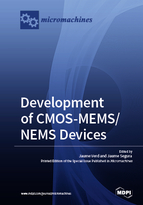Development of CMOS-MEMS/NEMS Devices
A special issue of Micromachines (ISSN 2072-666X). This special issue belongs to the section "A:Physics".
Deadline for manuscript submissions: closed (30 September 2018) | Viewed by 55890
Special Issue Editors
Interests: CMOS-MEMS/NEMS devices; MEMS resonators nonlinearities; VLSI CMOS design
Special Issue Information
Dear Colleagues,
Micro and nano-electro-mechanical system (M/NEMS) devices constitute key technological building blocks to enable increased additional functionalities within Integrated Circuits (ICs) in the More-Than-Moore era, as described in the International Technology Roadmap for Semiconductors. The CMOS ICs and M/NEMS dies can be combined in the same package (SiP), or integrated within a single chip (SoC). In the SoC approach the M/NEMS devices are monolithically integrated together with CMOS circuitry allowing the development of compact and low-cost CMOS-M/NEMS devices for multiple applications (physical sensors, chemical sensors, biosensors, actuators, energy actuators, filters, mechanical relays, and others). On-chip CMOS electronics integration can overcome limitations related to the extremely low-level signals in sub-micrometer and nanometer scale electromechanical transducers enabling novel breakthrough applications. This Special Issue aims to gather high quality research contributions dealing with MEMS and NEMS devices monolithically integrated with CMOS, independently of the final application and fabrication approach adopted (MEMS-first, interleaved MEMS, MEMS-last or others).
Dr. Jaume Verd
Prof. Dr. Jaume Segura
Guest Editors
Manuscript Submission Information
Manuscripts should be submitted online at www.mdpi.com by registering and logging in to this website. Once you are registered, click here to go to the submission form. Manuscripts can be submitted until the deadline. All submissions that pass pre-check are peer-reviewed. Accepted papers will be published continuously in the journal (as soon as accepted) and will be listed together on the special issue website. Research articles, review articles as well as short communications are invited. For planned papers, a title and short abstract (about 100 words) can be sent to the Editorial Office for announcement on this website.
Submitted manuscripts should not have been published previously, nor be under consideration for publication elsewhere (except conference proceedings papers). All manuscripts are thoroughly refereed through a single-blind peer-review process. A guide for authors and other relevant information for submission of manuscripts is available on the Instructions for Authors page. Micromachines is an international peer-reviewed open access monthly journal published by MDPI.
Please visit the Instructions for Authors page before submitting a manuscript. The Article Processing Charge (APC) for publication in this open access journal is 2600 CHF (Swiss Francs). Submitted papers should be well formatted and use good English. Authors may use MDPI's English editing service prior to publication or during author revisions.
Keywords
- MEMS/NEMS sensors
- CMOS-MEMS/NEMS Fabrication technologies
- RF MEMS and Oscillators
- Nonlinearities and Modelling
- MEMS/NEMS actuators
- Power MEMS
- Mechanical relays







